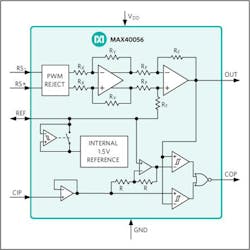Bidirectional Current-Sense Amp Boosts Motor Efficiency, Reduces Vibration
Current-sense amplifiers monitor current flow through a shunt (sense) resistor and provide closed-loop feedback of system loads. Complex, sensitive systems such as self-driving vehicles require extremely accurate sensing feedback to provide a high level of functionality and increased safety. This is particularly true in the electric-vehicle segment, where current sensors are needed to control energy flow and optimize efficiency in subsystems such as on-board chargers, dc-dc converters, traction inverters, and battery management systems.
To meet these needs, Maxim Integrated Products unveiled the MAX40056 bidirectional current-sense amplifier with patented pulse-width-modulation (PWM) rejection (see figure). The device is well-suited for phase-current monitoring of inductive loads, such as motors and solenoids, where PWM is used to control the drive voltage and current.
Shown is a simplified block diagram of Maxim’s MAX40056 current-sense amplifier.
The MAX40056 uses an improved technique to help reject common-mode-input PWM edges with slew rates up to and beyond ±500 V/µs, and settles within 500 ns to provide 0.3% accurate, full-scale winding current measurement. Common-mode rejection ratio (CMRR) is typically 60 dB (50-V, ±500-V/µs input) and 140 dB dc.
According to Maxim, the patented PWM rejection scheme achieves four times faster settling time than competitive offerings. Thus, motor-control designers are able to increase drive frequency or decrease minimum duty cycle without sacrificing measurement accuracy.
Higher PWM frequency smoothes out the current flow and reduces torque ripple, resulting in more efficient motor operation. Accurate winding current measurement at low duty cycle helps reduce or virtually eliminate vibration when the motor is running at a slow speed. The MAX40056’s common-mode voltage range is −0.1 to +65 V, and has a protection range of −5 to 70 V to ensure the inductive kickback doesn’t damage the IC. With bidirectional sensing capability, it;s particularly applicable in dc motor control, as well as in other applications that require precise current measurements in noisy environments.
The MAX40056 has an internal +1.5-V reference for use with a nominal +3.3-V power supply. The reference can also be applied to drive an adjoining differential ADC. The reference offsets the output to indicate the direction of the input sensed current. Its REF pin can source current into external loads and helps to avoid the performance compromises resulting from routing reference voltages across noisy PCBs.
Alternatively, for higher supply voltages and higher full-scale output swings, the internal reference can be overridden by a higher-voltage, external reference. The internal or external reference may be used to define the trip threshold for the integrated overcurrent comparator. This can provide immediate indication of an overcurrent fault condition. The MAX40056 operates over the full −40 to +125°C temperature range and runs from a supply voltage of +2.7 to +5.5 V.
"The MAX40056's high PWM rejection and fast settling time obtains current measurements in line with the motor windings for highest accuracy and greatest control in sensitive applications," says Dimitry Goder, director of applications and product definition for the Core Products Group at Maxim Integrated. "Its unique design architecture unlocks higher performance and future innovation in motor-control applications."
The MAX40056 is offered in a 2.02- x 1.4-mm, 8-pin wafer-level package (WLP) and 8-pin μMAX packages. It’s available at Maxim's website for $1.19 (1000-up, FOB USA); and also can be obtained from authorized distributors.
The MAX40056EVKIT evaluation kit is available for $69. This EV kit demonstrates the MAX40056FAUA+ in an 8-pin µMAX package, with gain = 50 V/V. For other available pin-compatible options (MAX40056TAUA+, Gain = 20V/V, MAX40056HAUA+, Gain = 10V/V), contact the factory.


